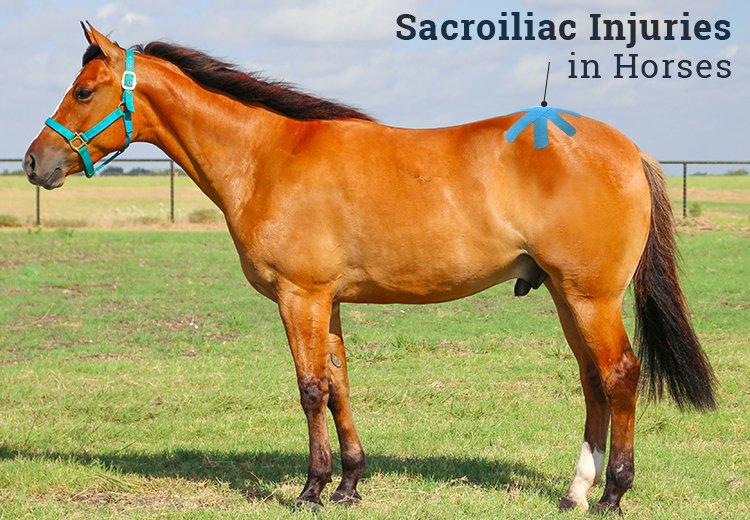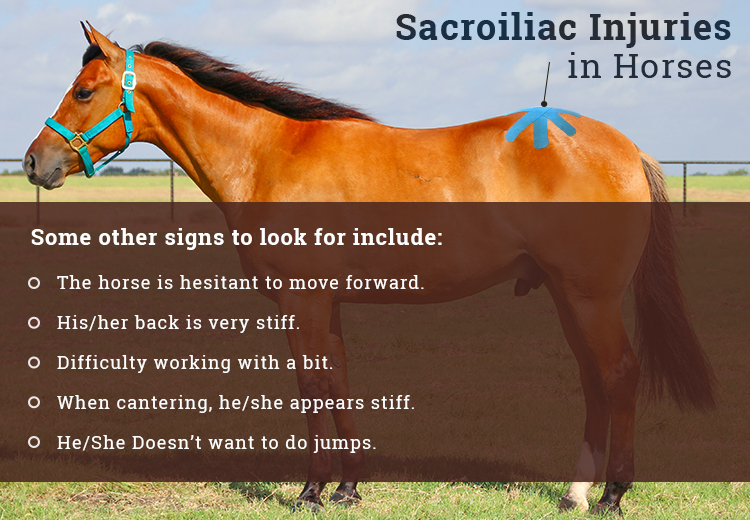-
Popular Brands View All BrandsPopular Brands View All BrandsPopular Brands View All BrandsPopular Brands View All BrandsPopular Brands View All Brands
- Dogs
- Cats
- Brands
- New Arrivals
- Below R150
- Refer & Save More
- Summer Season Sale
Oct 30, 2018

The sacroiliac joint is where the spine and pelvis meet. The sacrum is the end of the spine and the ilium is a bone part of the pelvis. This area is found at the top of the horses’ rump, below the gluteal muscles.
Sacroiliac injuries can initially be hard to recognise or diagnose. Identifying the problem early can prevent long term damage and, hopefully, correct the problem quicker and earlier than if it went unnoticed.
How do horses get these injuries?
Sacroiliac injuries mostly occur as a result of a fall, or some other accident, causing instability in the joint. This instability may give rise to chronic pain in the joint and further wear and tear. Performance horses undergo great mechanical stress on their joints and one of the common areas affected is the lower back, or sacroiliac region. Some studies have recorded that show jumping and dressage exert more mechanical stress on this joint than other activities. These horses also tend to be taller and heavier than the average horse.
When the joint is subject to stress, the ligaments may partially or completely tear, resulting in inflammation and pain. If left untreated, or if the joint undergoes repetitive stress, osteoarthritis may occur in the joint.
Diagnosis
Correctly diagnosing the injury is important for managing and treating the problem. Some racehorses get stress fractures of the pelvis over the sacroiliac joint which can mimic osteoarthritis of the joint.
As mentioned previously, these joint problems can be hard to diagnose. The joint is not like the hock where you can palpate it easily and assess range of motion. The sacroiliac joint is hidden under the deep gluteal layers. The first signs of a possible problem may be poorer performance from your horse or a reluctance to work. The farrier may find it difficult to shoe your horse, especially the hind legs.
The symptoms are sometimes easier to see when your horse is being ridden or is at a canter. These activities put strain on the joint and sometimes the rider may feel a problem even if there is no obvious sign of lameness.
Some other signs to look for include:

If the injury is more chronic you may notice the left and right gluteal muscles are not symmetrical, meaning there is muscle wasting on the side with the joint problem. However, this asymmetry does not mean a definite sacroiliac joint problem, the problem could be lower down the leg.
Your veterinarian will need to try and establish the problem, which you can see is challenging. Giving your veterinarian your horse’s full performance history and allowing a complete clinical exam are the starting points.
Your veterinarian may need to do some imaging, such as ultrasounds, to aid in finding a diagnosis.
What is the treatment?
Treatment is different for each horse. It depends on the severity of the problem and how quickly different horses respond to each treatment step. Often it involves medication, rest and physical therapy.
Medication is aimed at reducing the inflammation of the joint which will help alleviate pain. These may be anti-inflammatory drugs or local cortisone injections into the joint or around the affected ligament.
Rest allows time for the joint and or ligament to heal. Rest doesn’t mean stop all exercise, but rather reduce the work load as to reduce the stresses placed on the joint. Some exercise is needed to build up the muscles which help support the joints. Your veterinarian will help guide you in do’s and don’ts while treating your horse.
Physical therapy is used to help relax strained muscles around the effected joint. Strained muscles limit joint movement and place added strain on the joint. Sometimes chiropractor and acupuncture treatments may be used.
Prognosis
A mild sacroiliac injury has a good prognosis provided it is treated correctly. Recovery should be complete and your horse should have no trouble returning to his/her full work load in due time.
The more severe injuries involving osteoarthritis and ligament injuries have a guarded prognosis with being able to return back to their original high performance work not being guaranteed.
Research has shown that if your horse responds very well to treatment, a full recovery is much more likely. Recovery may take weeks or months to occur, so it is not a quick fix.
Nov 17, 2025
Seeing your furry companions itch incessantly due to fleas can be stressful. Fleas are blood-sucking parasites that not only make your pet ...
Nov 06, 2025
Black Friday & Cyber Monday are the most awaited times of the year that bring along the biggest shopping season of the year. While we m...